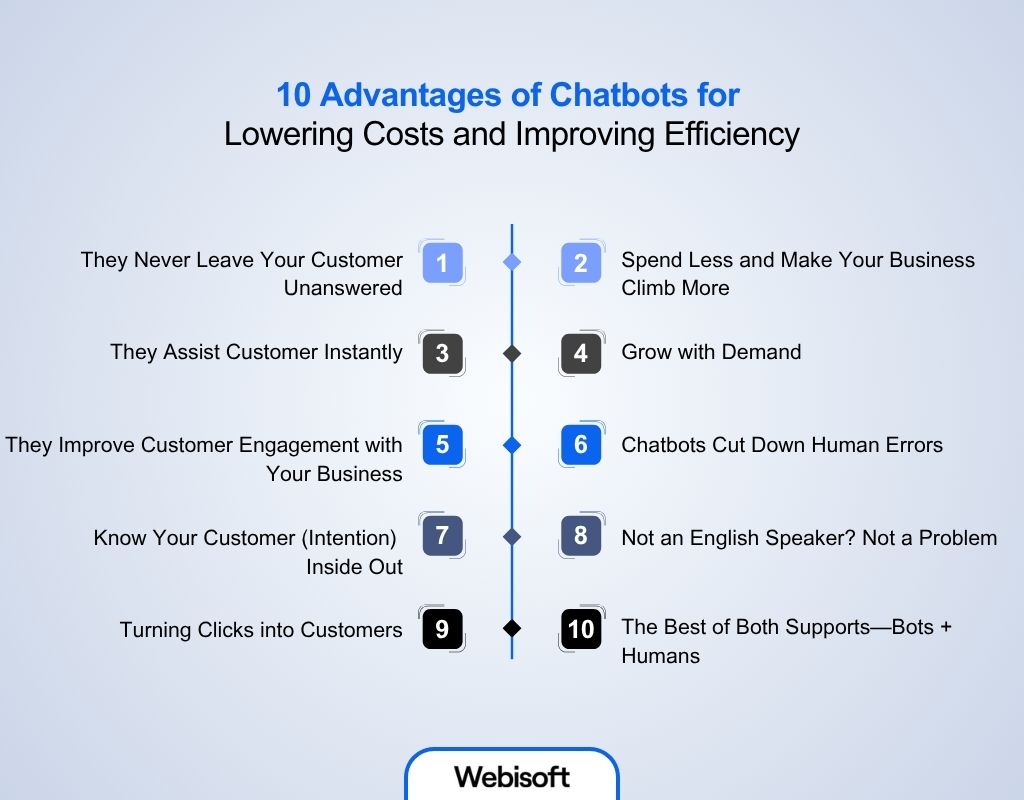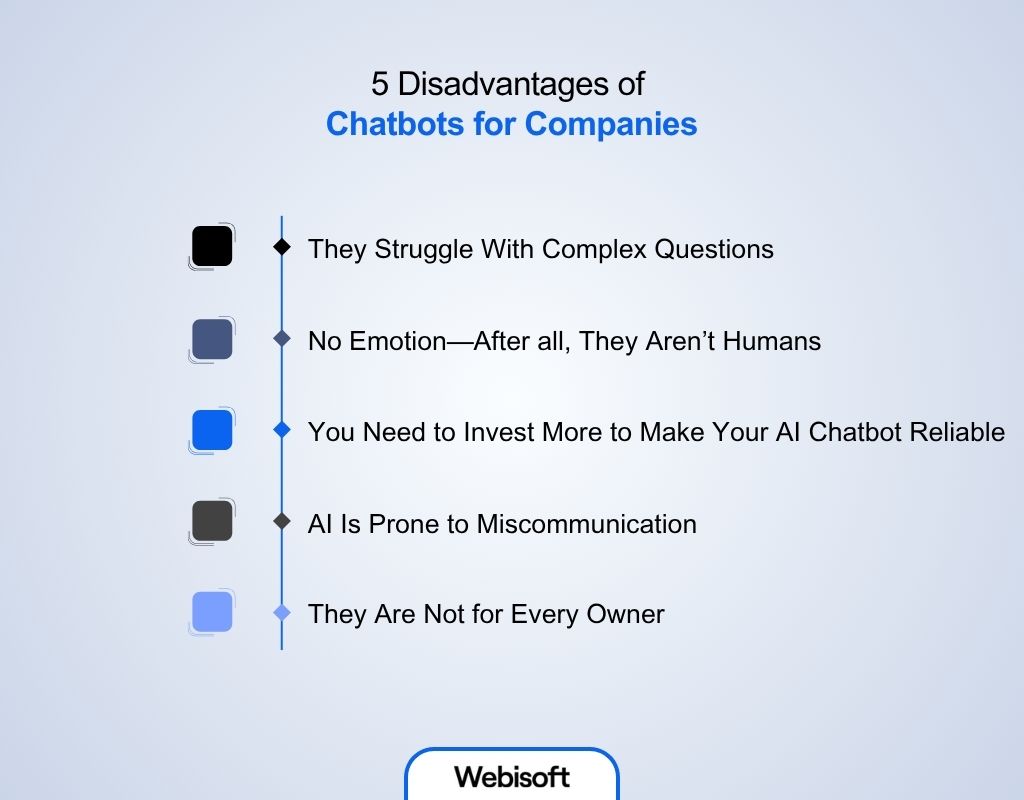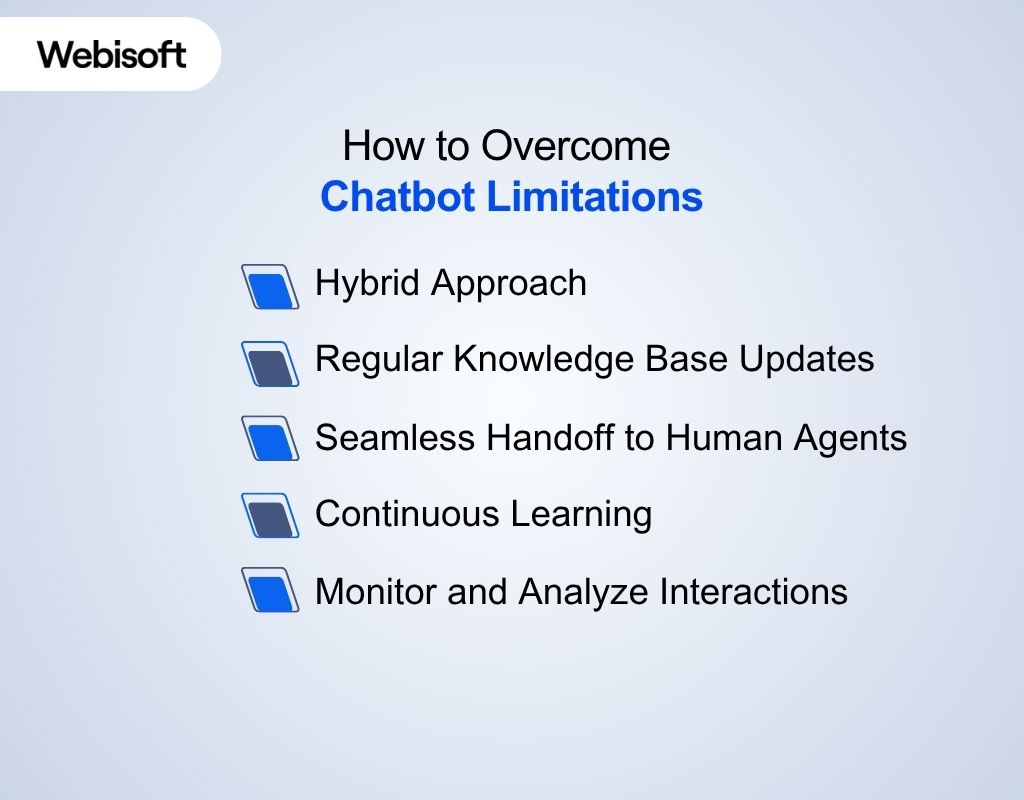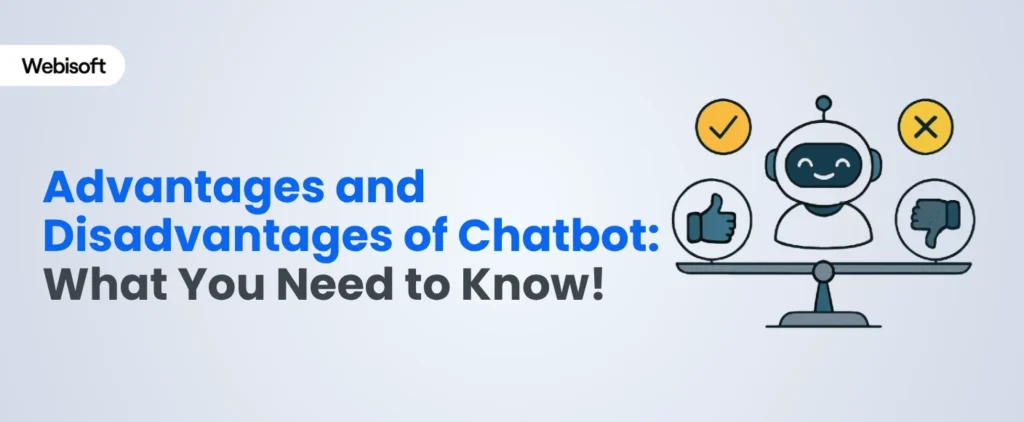Chatbots are changing the way businesses handle customer support. They offer quick responses, reduce costs, and work 24/7. But they also have limits. They can’t replace human interactions in every situation.
Before you decide if a chatbot is right for you, it’s important to look at both the pros and cons. In this guide, you’ll learn how chatbots can help your business, where they might fall short, and how to use them effectively.
Contents
- 1 10 Advantages of Chatbots for Lowering Costs and Improving Efficiency
- 1.1 1. They Never Leave Your Customer Unanswered
- 1.2 2. Spend Less and Make Your Business Climb More
- 1.3 3. They Assist Customer Instantly
- 1.4 4. Grow with Demand
- 1.5 5. They Improve Customer Engagement with Your Business
- 1.6 6. Chatbots Cut Down Human Errors
- 1.7 7. Know Your Customer (Intention) Inside Out
- 1.8 8. Not an English Speaker? Not a Problem
- 1.9 9. Turning Clicks into Customers
- 1.10 10. The Best of Both Supports—Bots + Humans
- 2 5 Disadvantages of Chatbots for Companies
- 3 How to Overcome Chatbot Limitations
- 4 Conclusion
- 5 FAQs
10 Advantages of Chatbots for Lowering Costs and Improving Efficiency

Chatbots are changing how businesses interact with customers. They automate responses, scale support, and reduce costs, all while keeping service fast and efficient. Whether you’re a business owner, student, or educator, chatbots offer real benefits.
1. They Never Leave Your Customer Unanswered
You no longer have to wait for business hours to get help. Chatbots work around the clock, providing instant support—even on weekends and holidays. In fact, according to Tidio’s survey, around 82% of customers prefer initial communication with a chatbot instead of waiting for a human agent.
This is especially useful for businesses serving global customers in different time zones.
A chatbot can answer common questions, troubleshoot problems, and suggest products without needing a human agent. This keeps businesses accessible at all times and makes customers feel valued.
For students and educators, chatbots keep learning uninterrupted. They offer automated assignment help, exam reminders, and quick answers to student queries, making education more accessible no matter the time or schedule.
2. Spend Less and Make Your Business Climb More
Customer support can be expensive. Hiring, training, and managing support teams adds up fast, especially when dealing with repetitive questions.
Chatbots automate these routine tasks, helping businesses save time and money. Instead of spending thousands on extra hires, companies can handle more customer requests at a lower cost.
Many businesses see a 30-50% drop in support expenses after using chatbots, making them a smart financial choice.
For universities and online learning platforms, cost efficiency is a big benefit. Chatbots help cut administrative costs while still providing instant support to students. This makes them a budget-friendly option for education providers.
3. They Assist Customer Instantly
Customers expect instant solutions when they reach out for support. Chatbots respond immediately, retrieving relevant information from databases, AI-based FAQs, or AI-driven learning models.
In 2023, 8×8’s study stated that an AI chatbot can save 92% of a customer’s time by resolving the issue immediately!
The benefits of chatbots for customers include quick access to information, troubleshooting guidance, and seamless transactions. Instead of waiting on hold, customers get their answers in seconds, leading to higher satisfaction and fewer abandoned support requests.
Hence, a chatbot is especially useful for industries with high inquiry volumes, such as e-commerce, banking, and telecom.
4. Grow with Demand
“The conversational AI market is projected to grow from USD 13.2 billion in 2024 to USD 49.9 billion by 2030” — Markets and Markets
A business experiencing rapid growth or seasonal surges needs a scalable solution. Chatbots handle an unlimited number of interactions simultaneously, unlike human agents who can only manage one at a time.
This is particularly valuable during high-traffic periods like Black Friday sales, seasonal promotions, or software launches when inquiries spike. Businesses can handle peak demand without delays, ensuring a smooth customer experience.
For instance, the total e-commerce revenue in the US during the 2024 holiday season sale rose by $10 billion after using a customer chatbot.
Not only that, it’s useful during exam seasons in education too, where institutions receive thousands of student inquiries. A chatbot makes sure that students get answers instantly, even when demand spikes.
5. They Improve Customer Engagement with Your Business
Engagement is more than just answering questions—it’s about creating meaningful interactions. AI-powered chatbots analyze customer behavior and preferences to provide relevant responses.
In e-commerce, chatbots suggest products based on past purchases. For example, Big Sur reported that AI chatbots increased conversion rates by 15%.
Again, chatbots guide students toward the right courses in education. In healthcare, AI chatbots remind patients of upcoming appointments and offer instant responses to health-related inquiries.
This level of personalization makes the experience more interactive and drives conversions.
6. Chatbots Cut Down Human Errors
Even the most experienced human agents can make mistakes and misunderstand customer requests. It may lead to unintentional incorrect information delivery or getting overwhelmed by multiple queries.
Chatbots eliminate human error by delivering consistent, data-driven responses. In industries like banking, finance, and healthcare, accuracy is critical.
In fact, financial institutions are increasingly deploying chatbots to handle customer inquiries. For instance, the Commonwealth Bank of Australia utilizes AI-powered chatbots to manage approximately 50,000 daily customer queries, simplifying processes and reducing the potential for human error.
7. Know Your Customer (Intention) Inside Out
Chatbots do more than answer questions. They collect valuable data from every conversation, helping you understand your customers better.
They track:
- Frequently asked questions to spot knowledge gaps.
- Common pain points to improve products or services.
- User behavior trends to refine marketing strategies.
With this data, you can make smarter decisions, improve customer support, and create a better experience for your audience. Instead of guessing what customers need, you get real insights that help you serve them better.
For example, Terpel, utilized a WhatsApp chatbot to capture and analyze customer data in real-time. This approach proved more effective than traditional channels like email or SMS, enabling Terpel to gain deeper insights into customer needs and preferences.
8. Not an English Speaker? Not a Problem
If you serve international customers, language barriers can be a challenge. AI-powered chatbots solve this by offering multilingual support, ensuring users get help in their preferred language.
This is especially useful for businesses in diverse markets. Instead of hiring agents fluent in multiple languages, you can train a chatbot to handle conversations automatically. It saves time, reduces costs, and improves customer experience.
For instance, automating customer service through chatbots with multilanguage support can reduce customer service costs by up to 30%, as they can handle up to 80% of routine tasks without human intervention.
9. Turning Clicks into Customers
Chatbots aren’t just for support. They also work as virtual sales agents, guiding visitors through the buying process.
For example, when someone visits your website, a chatbot can:
- Ask about their needs and suggest relevant products or services.
- Offer discounts or promotions to encourage a purchase.
- Collect emails and contact info for future marketing campaigns.
This automation boosts lead generation and increases sales without extra effort from your team.
10. The Best of Both Supports—Bots + Humans
Chatbots are powerful, but they aren’t perfect. Some situations need a human touch, especially when emotions or complex issues are involved.
The best solution is hybrid support—chatbots handle routine questions, while human agents take over when needed. This ensures customers always get the right level of help while reducing the workload for your support team.
5 Disadvantages of Chatbots for Companies

Chatbots can be a game-changer. But they’re not perfect. Sometimes, relying too much on them can lead to frustrated customers and missed opportunities.
Here are some chatbot challenges you should know:
1. They Struggle With Complex Questions
Chatbots are great at handling simple, repetitive tasks. But when customers ask for something unexpected or complicated, things can go wrong.
A rule-based chatbot only understands what it’s programmed for. If a customer uses slang or asks a unique question, the bot may give an irrelevant answer.
For instance, Virgin Money’s AI chatbot mistakenly reprimanded a customer for using the word “virgin” when inquiring about merging ISAs. It highlights the limitations of chatbots in understanding context.
An AI-powered application of chatbot is more advanced. They can learn and improve over time. But they still need training to understand complex interactions. Without enough data, they can misinterpret questions or respond incorrectly.
Many customers find that chatbots struggle with complex inquiries, with 75% reporting that bots often fail to provide accurate responses when dealing with intricate issues.
2. No Emotion—After all, They Aren’t Humans
One significant drawback of chatbots is their inability to convey empathy or emotional intelligence. While they can process and respond to inquiries quickly, their interactions often feel robotic and impersonal.
Customers may appreciate the speed, but they can sense the lack of human connection, which can detract from their overall experience.
Certain situations, such as dealing with angry or distressed customers, require more than just efficient responses. These interactions often need emotional support or nuanced communication that chatbots simply cannot provide.
Klarna’s Strategy Shift experienced challenges with their chatbot’s performance, including providing incorrect information and lacking empathetic responses. These issues led to a strategic shift, rebalancing their customer service approach to incorporate more human agents alongside AI.
3. You Need to Invest More to Make Your AI Chatbot Reliable
One of the main challenges when implementing AI-powered chatbots is the significant initial investment. Developing a custom AI chatbot can range from $10,000 to over $150,000, depending on complexity and features.
Setting up these advanced systems requires time, resources, and a skilled team to ensure they are tailored to your business needs. This upfront cost can be a deterrent for smaller companies or those with limited budgets.
Moreover, AI chatbots need continuous updates to stay relevant and efficient. As your business evolves, so must the chatbot’s ability to handle new inquiries and adapt to changing customer behavior.
Regular maintenance is essential, adding to the long-term costs of using these tools.
4. AI Is Prone to Miscommunication
A significant concern with chatbots is the risk of miscommunication. This is particularly beneficial for healthcare and pharmaceutical services. Online pharmacies like Buy Diazepam ensure customers can get instant answers about medications, dosages, and precautions through chatbot support.
In the context of a chatbot as a teaching tool, these miscommunications can have serious consequences. In November 2024, Gemini responded abusively to a student’s request for homework assistance, telling her to “please die.”
This alarming response highlighted significant flaws in the chatbot’s programming and raised concerns about the potential risks of AI interactions. It’s not only one of the disadvantages of chatbots in education but also in businesses, healthcare, and banks.
5. They Are Not for Every Owner
Not every business can benefit from chatbot technology. Some industries, such as luxury services or mental health support, rely heavily on human interaction to provide personalized care.
In these fields, a chatbot’s inability to offer empathy or nuanced responses can create a disconnect with the customer.
For businesses offering high-touch services, like luxury brands or sensitive sectors, there can be some disadvantages of chatbots in customer service. Customers expect personal, empathetic service that a bot simply cannot provide.
While chatbots excel in automating basic tasks, they fall short in situations that demand emotional intelligence or complex problem-solving.
How to Overcome Chatbot Limitations

Indeed, there are many advantages and disadvantages of chatbot for students, businesses, and customers. But chatbots also come with certain limitations that can impact the user experience.
However, there are several proven strategies to overcome these challenges. Here’s a breakdown of the most effective ways to address these limitations.
- Hybrid Approach: Combine chatbots with human agents to handle simple tasks and pass complex queries to humans. It ensures smooth transitions and better customer satisfaction.
- Regular Knowledge Base Updates: Keep the chatbot’s information current by regularly updating its knowledge base with the latest products, services, and policies for accurate responses.
- Seamless Handoff to Human Agents: Set up an automatic handoff to human agents when a chatbot reaches its limits, reducing frustration and ensuring the customer feels heard.
- Continuous Learning (Machine Learning): Use machine learning to help the chatbot improve over time by learning from past interactions, enabling it to handle more complex queries.
- Monitor and Analyze Interactions: Regularly analyze chatbot conversations to identify weaknesses and refine their performance for better customer experience management and efficiency.
Conclusion
To summarize the advantages and disadvantages of chatbot, a chatbot can facilitate a company in many ways.
Chatbots can make your business faster and more efficient. But they’re not a one-size-fits-all solution.
To get the best results, balance automation with human support. Let chatbots handle simple tasks and leave complex issues to real people.
Thinking about using a chatbot? Make sure it’s built the right way!
FAQs
Can chatbots fully replace human customer support agents?
While chatbots can handle many basic inquiries, they cannot completely replace human agents, especially in situations that require empathy, creativity, or deep knowledge.
Can chatbots improve the efficiency of your customer service team?
Yes, chatbots can handle repetitive tasks and frequently asked questions, freeing up your human agents to focus on more complex or sensitive issues and improving overall efficiency.
How do you know if your business should implement a chatbot?
If your business handles a high volume of simple, repetitive customer inquiries, implementing a chatbot could significantly enhance efficiency and customer satisfaction. However, industries that require deep personalization may not benefit as much.
